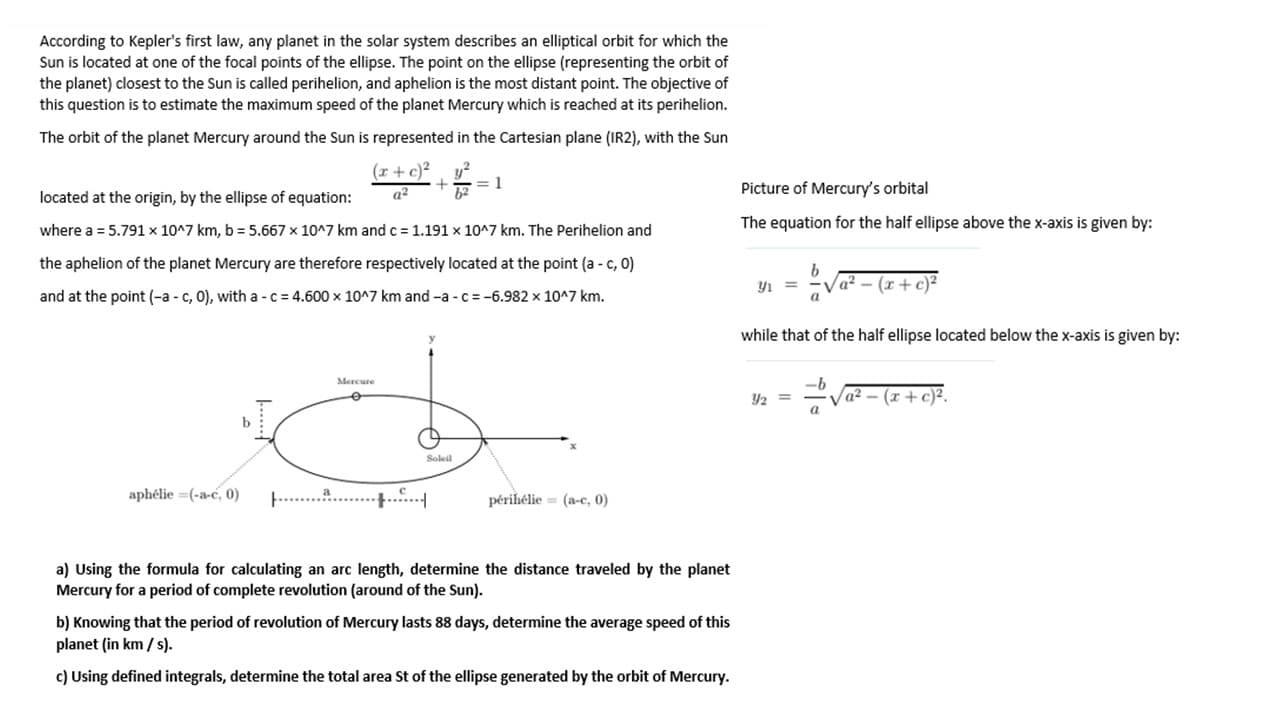According to Kepler's first law, any planet in the solar system describes an elliptical orbit for which the Sun is located at one of the focal points of the ellipse. The point on the ellipse (representing the orbit of the planet) closest to the Sun is called perihelion, and aphelion is the most distant point. The objective of this question is to estimate the maximum speed of the planet Mercury which is reached at its perihelion. The orbit of the planet Mercury around the Sun is represented in the Cartesian plane (IR2), with the Sun (r+ c)² y? located at the origin, by the ellipse of equation: where a = 5.791 x 10^7 km, b = 5.667 x 10^7 km and c = 1.191 x 10^7 km. The Perihelion and the aphelion of the planet Mercury are therefore respectively located at the point (a - c, 0) and at the point (-a - c, 0), with a - c = 4.600 x 10^7 km and -a -c = -6.982 x 10^7 km. Mercure Soleil aphélie =(-a-c, 0) périhélie = (a-c, 0) a) Using the formula for calculating an arc length, determine the distance traveled by the planet Mercury for a period of complete revolution (around of the Sun). b) Knowing that the period of revolution of Mercury lasts 88 days, determine the average speed of this planet (in km / s). c) Using defined integrals, determine the total area St of the ellipse generated by the orbit of Mercury.
According to Kepler's first law, any planet in the solar system describes an elliptical orbit for which the Sun is located at one of the focal points of the ellipse. The point on the ellipse (representing the orbit of the planet) closest to the Sun is called perihelion, and aphelion is the most distant point. The objective of this question is to estimate the maximum speed of the planet Mercury which is reached at its perihelion. The orbit of the planet Mercury around the Sun is represented in the Cartesian plane (IR2), with the Sun (r+ c)² y? located at the origin, by the ellipse of equation: where a = 5.791 x 10^7 km, b = 5.667 x 10^7 km and c = 1.191 x 10^7 km. The Perihelion and the aphelion of the planet Mercury are therefore respectively located at the point (a - c, 0) and at the point (-a - c, 0), with a - c = 4.600 x 10^7 km and -a -c = -6.982 x 10^7 km. Mercure Soleil aphélie =(-a-c, 0) périhélie = (a-c, 0) a) Using the formula for calculating an arc length, determine the distance traveled by the planet Mercury for a period of complete revolution (around of the Sun). b) Knowing that the period of revolution of Mercury lasts 88 days, determine the average speed of this planet (in km / s). c) Using defined integrals, determine the total area St of the ellipse generated by the orbit of Mercury.
Algebra & Trigonometry with Analytic Geometry
13th Edition
ISBN:9781133382119
Author:Swokowski
Publisher:Swokowski
Chapter11: Topics From Analytic Geometry
Section11.3: Hyperbolas
Problem 35E
Related questions
Concept explainers
Equations and Inequations
Equations and inequalities describe the relationship between two mathematical expressions.
Linear Functions
A linear function can just be a constant, or it can be the constant multiplied with the variable like x or y. If the variables are of the form, x2, x1/2 or y2 it is not linear. The exponent over the variables should always be 1.
Question
100%
Hello I need to solve part a, b and c. Thank you

Transcribed Image Text:According to Kepler's first law, any planet in the solar system describes an elliptical orbit for which the
Sun is located at one of the focal points of the ellipse. The point on the ellipse (representing the orbit of
the planet) closest to the Sun is called perihelion, and aphelion is the most distant point. The objective of
this question is to estimate the maximum speed of the planet Mercury which is reached at its perihelion.
The orbit of the planet Mercury around the Sun is represented in the Cartesian plane (IR2), with the Sun
(r+ c)²
y?
located at the origin, by the ellipse of equation:
where a = 5.791 x 10^7 km, b = 5.667 x 10^7 km and c = 1.191 x 10^7 km. The Perihelion and
the aphelion of the planet Mercury are therefore respectively located at the point (a - c, 0)
and at the point (-a - c, 0), with a - c = 4.600 x 10^7 km and -a -c = -6.982 x 10^7 km.
Mercure
Soleil
aphélie =(-a-c, 0)
périhélie = (a-c, 0)
a) Using the formula for calculating an arc length, determine the distance traveled by the planet
Mercury for a period of complete revolution (around of the Sun).
b) Knowing that the period of revolution of Mercury lasts 88 days, determine the average speed of this
planet (in km / s).
c) Using defined integrals, determine the total area St of the ellipse generated by the orbit of Mercury.
Expert Solution
This question has been solved!
Explore an expertly crafted, step-by-step solution for a thorough understanding of key concepts.
This is a popular solution!
Trending now
This is a popular solution!
Step by step
Solved in 7 steps with 8 images

Knowledge Booster
Learn more about
Need a deep-dive on the concept behind this application? Look no further. Learn more about this topic, advanced-math and related others by exploring similar questions and additional content below.Recommended textbooks for you

Algebra & Trigonometry with Analytic Geometry
Algebra
ISBN:
9781133382119
Author:
Swokowski
Publisher:
Cengage

College Algebra (MindTap Course List)
Algebra
ISBN:
9781305652231
Author:
R. David Gustafson, Jeff Hughes
Publisher:
Cengage Learning

Algebra & Trigonometry with Analytic Geometry
Algebra
ISBN:
9781133382119
Author:
Swokowski
Publisher:
Cengage

College Algebra (MindTap Course List)
Algebra
ISBN:
9781305652231
Author:
R. David Gustafson, Jeff Hughes
Publisher:
Cengage Learning